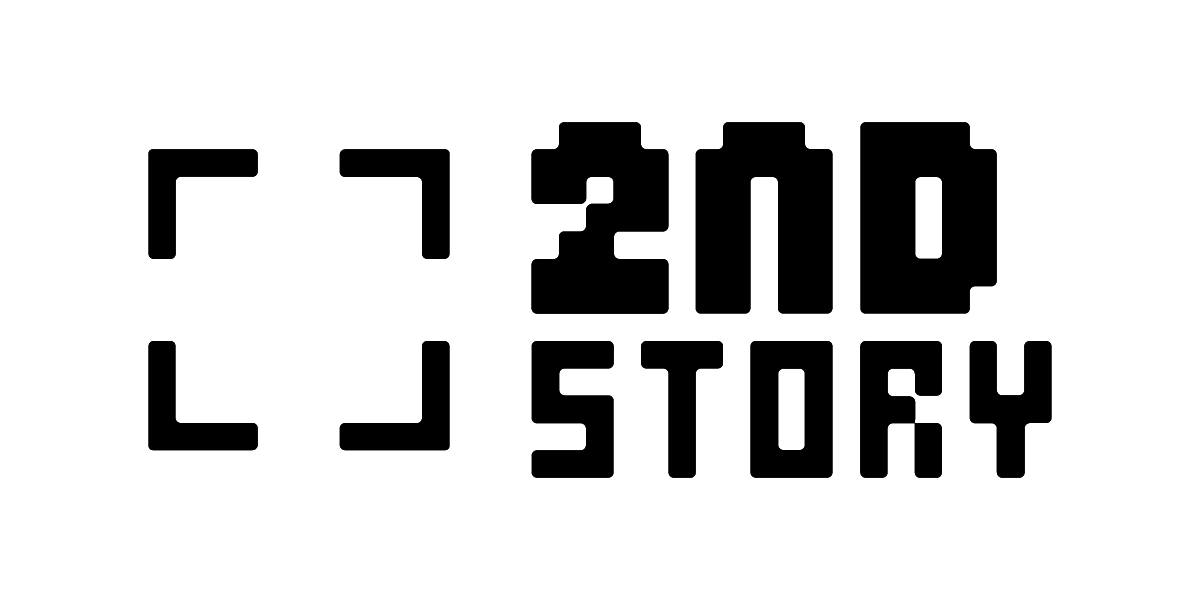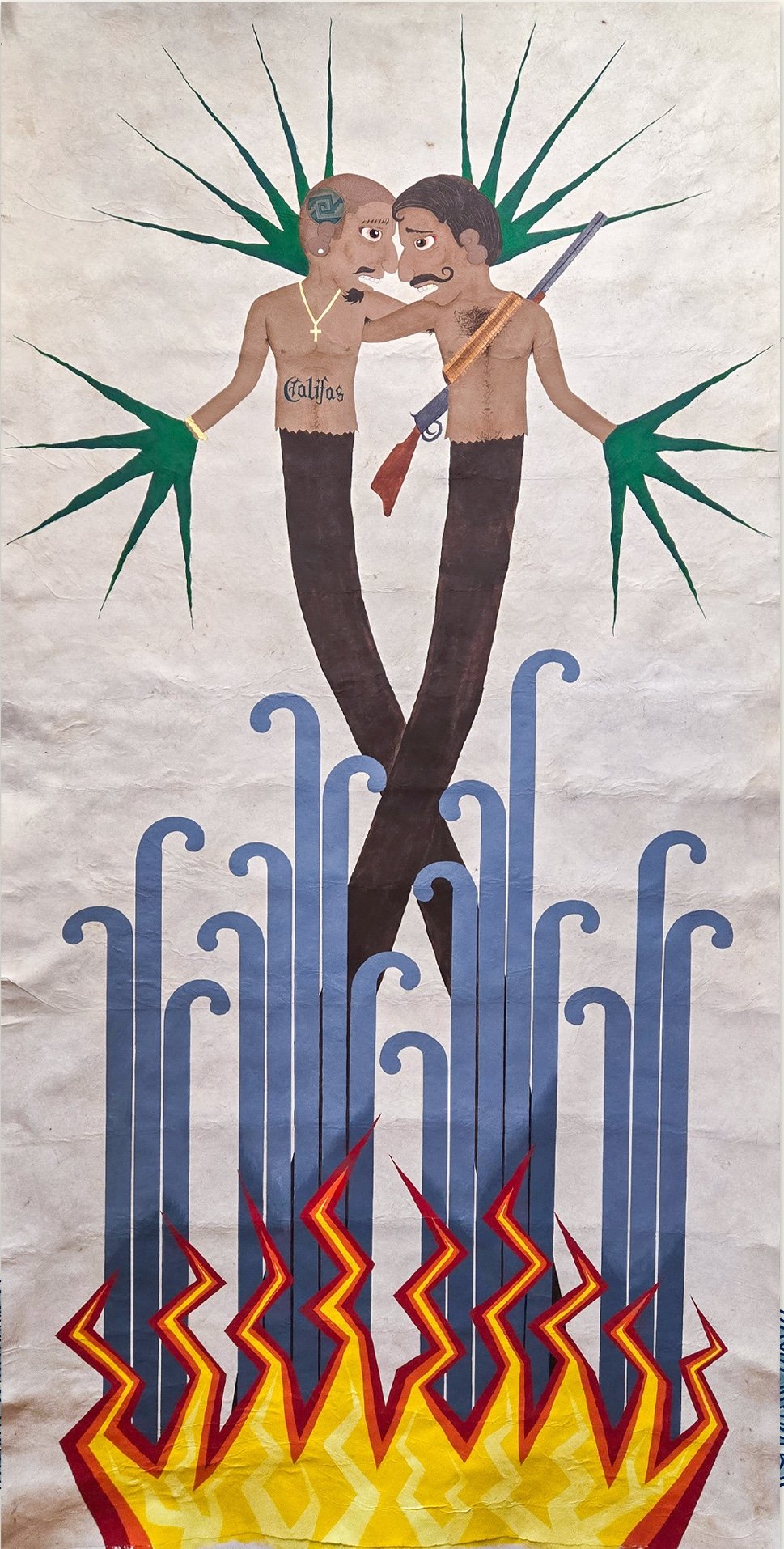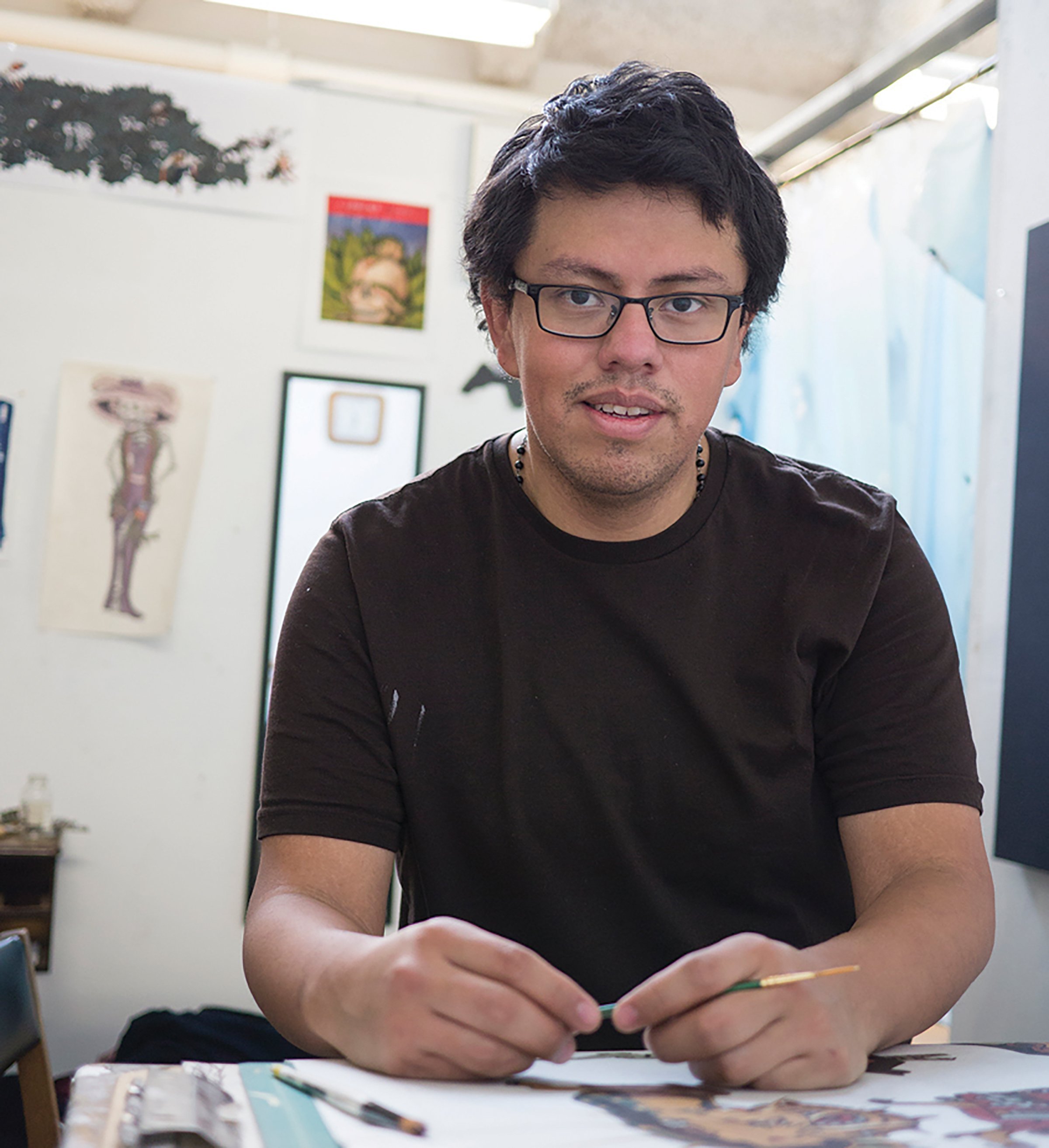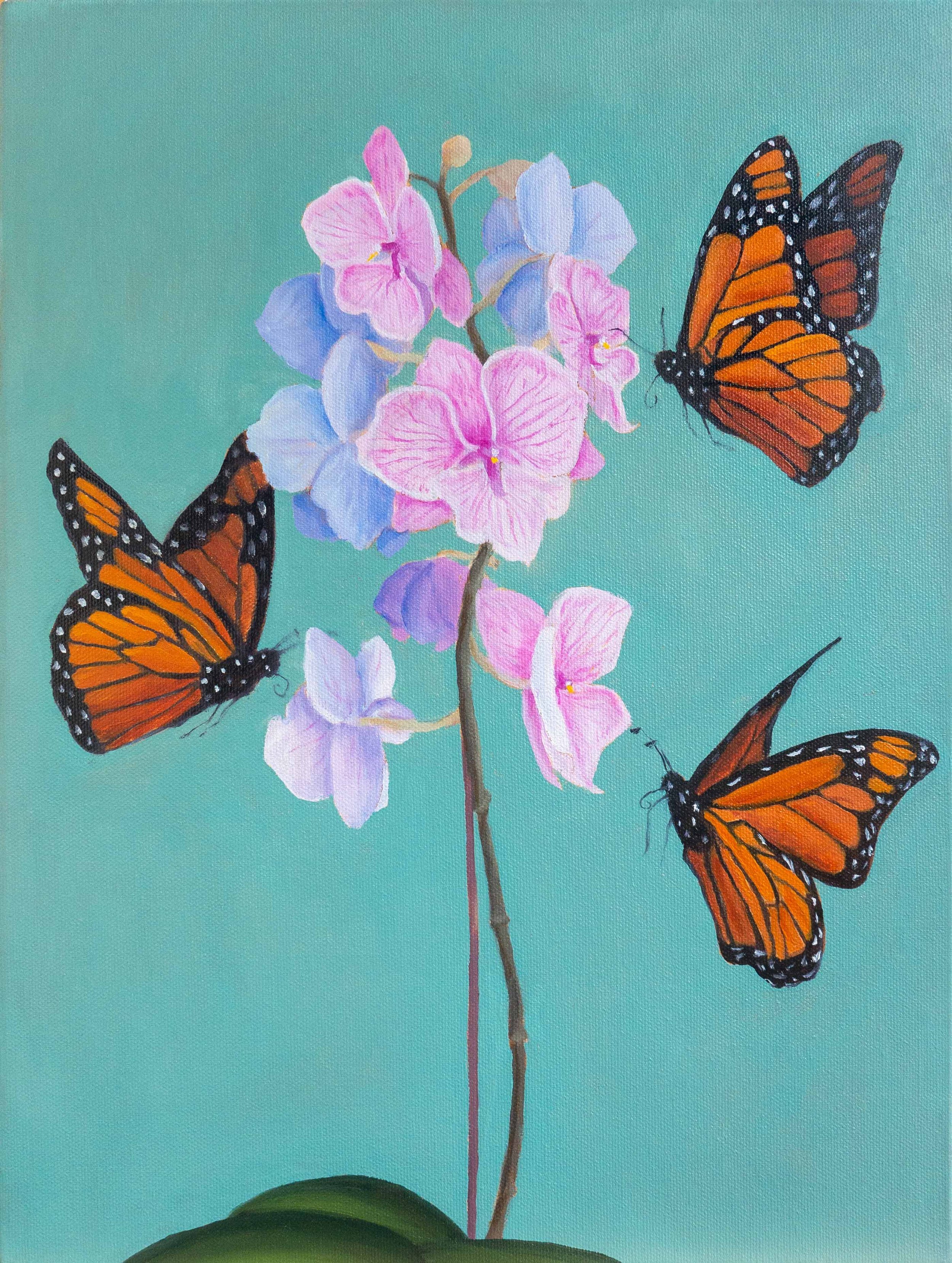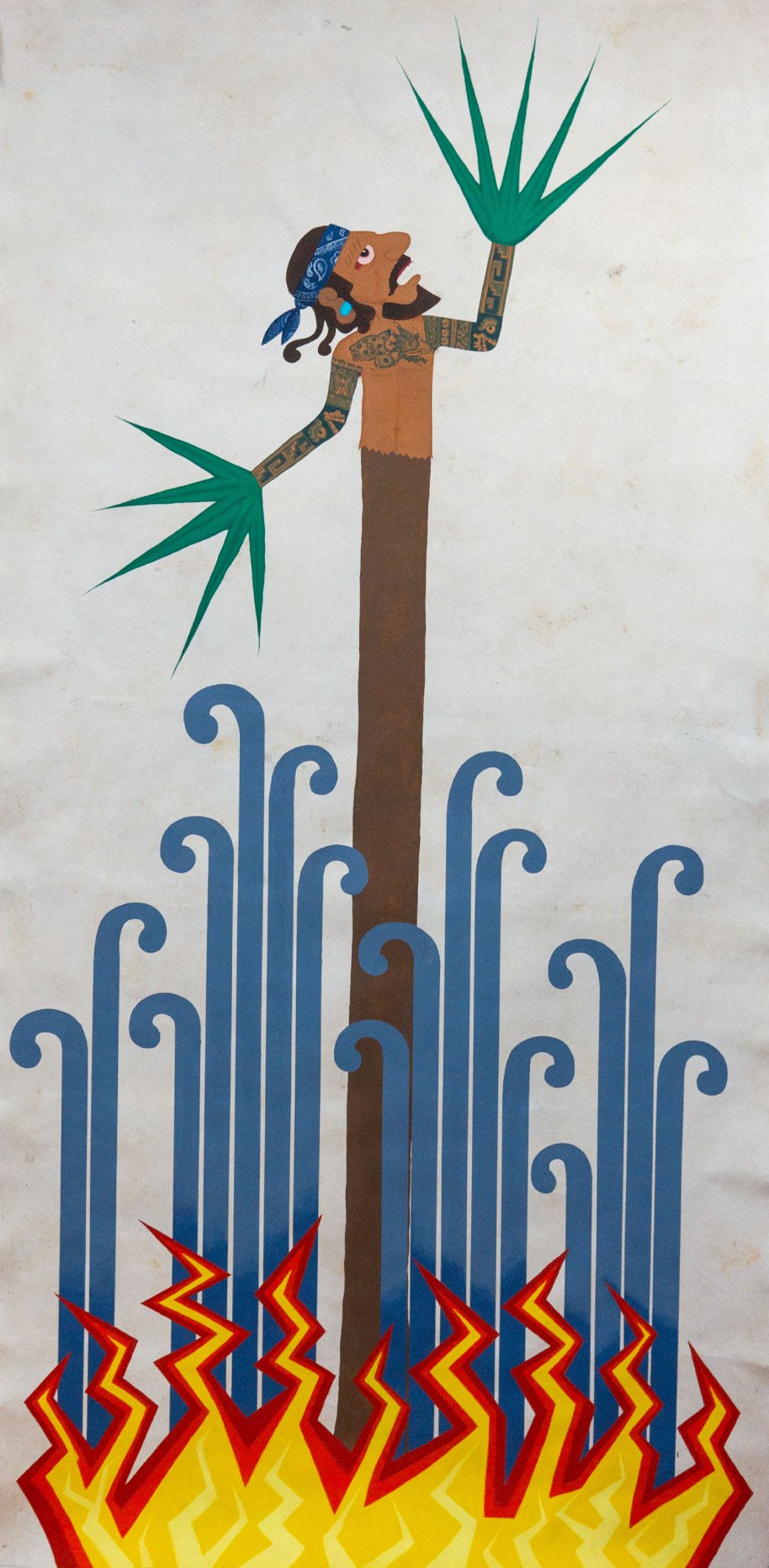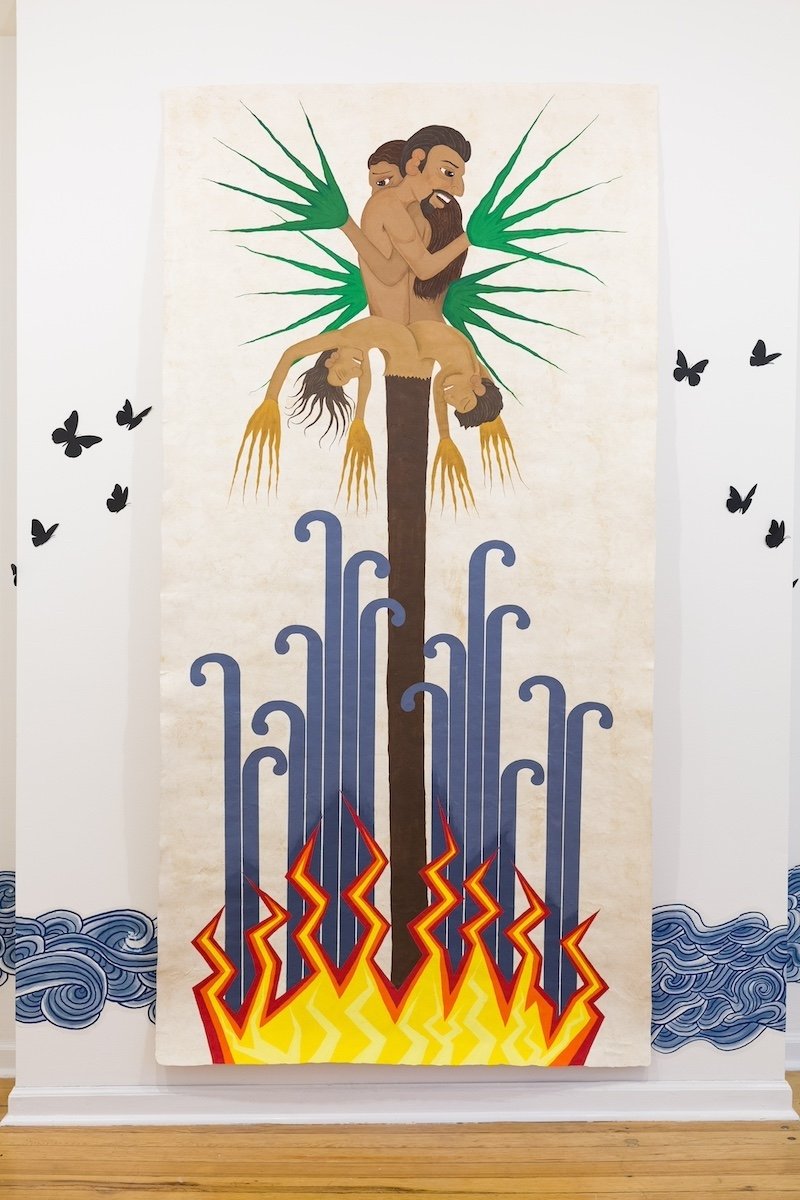ISRAEL CAMPOS
CLEANSING OF THE SENTINELS
April 20 - June 26, 2024
About |||||||
Israel Campos is a Los Angeles-based, queer, Chicano artist who creates prints and paintings that merge pre-Columbian iconographies with contemporary American culture. In Cleansing of the Sentinels, he presents five new large-scale paintings of anthropomorphized palm trees being subsumed by fire and water -- a meditation on the impacts of climate change on human and non-human life.
Campos' work builds from the Chicano/o art movement that emerged, among Mexican-Americans in the late 1960s, to resist assimilation, claim identity, and express the complexity of being caught between two cultures. He integrates surrealist strategies into his compositions, while simultaneously pulling visual and material inspiration from Mesoamerican codices. Like the ancient books he references, Campos paints on amate, a paper native to Mexico that is made from wild fig tree bark. His simplified forms, embrace of pictorial flatness, and use of symbols and glyphs point to his conscious rejection of Eurocentric artistic traditions. He merges these indigenous aesthetics with contemporary stylistic signifiers typical of the Chicano/a community where he was born and raised, in South Central L.A.: rolled bandanas tied across the forehead, gold hoop earrings, crucifix necklaces, and even an homage to the history of Mexican revolutionaries. Tattoos cleverly nod to imagery found in the Codex Borgia, while "Califa" refers to the Chicano name for the state of California.
In Cleansing of the Sentinels, Campos mobilizes his art to address urgent environmental concerns —- a crisis that has been particularly visible in Los Angeles, where raging wildfires and destructive flash flooding disproportionately impact the Latino community due to their large presence in the agricultural sector. However, this body of work challenges us to view fire as a cleansing force. In the artist's own words, "In the Mesoamerican tradition, chaos is viewed as an opportunity for regeneration. Chaos brings forth metamorphosis which can allow life to be renewed. This is a moment to reflect on how we can be better stewards of the land and honor the people who lived here before us."
Artist Statement |||||||
In 2007 a wildfire raged over the Hollywood Hills and the Hollywood sign came close to being engulfed in flames. L.A. mobilized a large-scale firefighting force to prevent one of the most iconic symbols of the city from being destroyed. The next morning the flames were extinguished but a thin layer of ash covered the streets and the scent of smoke permeated the air. Prior to this experience it seemed inconceivable for a wildfire to penetrate the heart of L.A. but this experience showcased how vulnerable the city was to the elements. Wildfires are now a seasonal occurrence in L.A. and the surrounding region. Smoke and ash are now interwoven into the fabric of the city.
The 2007 wildfire is the catalyst for the Cleansing of the Sentinels. The palm tree is the iconic symbol of Los Angeles but fire is now an equivalent symbol. The group of anthropomorphized palm trees engulfed in flames demonstrates how interconnected the environment is to the future of humanity. Climate change is negatively transforming our relationship with the environment and the effects are detrimental to our future. The body of work utilized pre-Columbian imagery to highlight the disproportionate effect of climate change to the Latino community due to their large presence in the agricultural sector.
Cleansing of the Sentinels utilizes fire as a cleansing force. As St. Augustine wrote, “The fire which makes gold shine makes chaff smoke.” The exhibit challenges the viewer to view the current environmental man-made catastrophe as an opportunity for reflection. In the Mesoamerican tradition, chaos is viewed as an opportunity for regeneration. Chaos brings forth metamorphosis which can allow life to be renewed. This is an opportunity to reflect on how we can be better stewards of the land and honor the people that lived here before us.
Artist Bio |||||||
Israel Campos is a Los Angeles-based, Chicano artist and master printmaker. He received his BA from the University of California Santa Cruz (2011) and an MFA from the University of Wisconsin‐Madison (2015).
His work is in the permanent collections of the Kohler Art Library, University of Wisconsin, Madison; Digital Art Research Center, University of California, Santa Cruz; Zuckerman Museum of Art, Kennesaw State University, GA; the Oregon College of Art and Craft, Portland, OR; and Digital & Graphic Art Research Center, Universidad de Vigo, Pontevedra, Spain.
Campos has exhibited his work in venues including the Oakland Museum of California (2023); The 3110 Gallery, Los Angeles, CA (2023); South Gate Museum and Art Gallery, South Gate, CA (2022); Emily Davis Gallery, Akron, OH (2022); Trout Museum of Art, Appleton, WI (2022); Nara Kasugano International Forum, Nara, Japan (2021); ArtHelix Gallery, New York, NY; the Ronna and Eric Hoffman Gallery of Contemporary Art, Portland, OR, among others.
He is an active member of the Vox Pop printmaking artist collective and the California Society of Printmakers. He also runs and operates Chayote Press, a collaborative printmaking studio in the Pico Union neighborhood of Los Angeles.
Los Cuates, 2024. Acrylic and 24k gold leaf on amate paper, mounted on canvas. 96 x 48 inches.
The Elements, 2004. Digital print on paper. 36 x 36 inches.
La Sagrada Familia, 2024. Acrylic on amate paper, mounted on canvas. 96 x 48 inches.
Mujer Divina, 2024. Acrylic and 24k gold leaf on amate paper, mounted on canvas. 96 x 48 inches.
La Catrina, 2024. Acrylic and 24k gold leaf on amate paper, mounted on canvas. 96 x 48 inches.
Orchids and Monarchs, 2023. Oil on canvas.
El Farsante, 2024. Acrylic on amate paper, mounted on canvas. 96 x 48 inches.
Pipevine Swallowtails and Toothpick Cactus, 2023. Oil on canvas.
Related Events
|||||
Related Events |||||
Exhibition Reception
Artist talk and opening reception for Israel Campos’s exhibition, Cleanings of the Sentinels.
April 20, 2024
Amate Workshop
Learn the ancient craft of cutting amate figurines from exhibiting artist Israel Campos.
April 21, 2024
Film Screening: CHICANA
A screening Sylvia Morales’ experimental film CHICANA. The film traces the history of Chicana and Mexican women from pre-Columbian times to the present.
May 17, 2024
Panel Discussion: Chicano/a Art Legacies
Artist Israel Campos in conversation with Dr. Martina Ayala, Professor Emeritus Jim Escalante, and Dr. Jennifer Gonzales.
June 3, 2024
Unraveling Mythstories of Ancient Mexico
Geoff and Sharisse McCafferty highlight how the ancient peoples of central Mexico envisioned themselves and their mythstories through their art, as well as their relationship with the sacred landscape.
